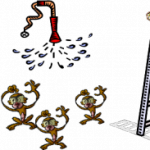 The theory of morphic resonance was proposed by Rupert Sheldrake a few decades ago now. It suggests that, in self organizing systems, a form of memory is inherited from systems that are similar to it. So things like the laws of nature, are in fact more like habits and rules of thumb.
The theory of morphic resonance was proposed by Rupert Sheldrake a few decades ago now. It suggests that, in self organizing systems, a form of memory is inherited from systems that are similar to it. So things like the laws of nature, are in fact more like habits and rules of thumb.
A nice example of this was a study published in 1976 that explored how monkeys learned, and more importantly, communicated behaviour throughout their tribe.
The researchers placed a number of monkeys in a cage, with a bunch of bananas hung from the ceiling, accessible by a ladder placed beneath the bunch. As you can imagine, it didn’t take long for the first monkey to scale the ladder and start munching on some bananas.
The next day however, when a fresh bunch of bananas was hung from the ceiling, the monkeys were sprayed with cold water whenever they tried to climb the ladder. Just as they quickly learned how to reach the bananas, they also quickly cottoned on that getting on the ladder was a recipe for a soaking.
This lesson quickly spread through the tribe, and the monkeys began holding back any of their peers that attempted to get to the bananas.
Here is where things get interesting. After each of the monkeys in the cage had become trained to avoid the ladder, the researchers switched one of them out for a new monkey. That is, a new monkey completely unaware of the soaking that potentially lie in wait for them if they try and climb the ladder.
Suffice to say, none of the remaining monkeys let their new colleague take the chance, quickly pouncing on him if he went near the ladder.
This trend continued, even as the researchers continued to substitute monkeys that had received a soaking with those that had not. Indeed, it continued even when there was not a single monkey left that had gotten wet having climbed the ladder.
It’s a telling example of how quickly the status quo can become established within a group, and I’m sure you’re all too familiar with examples of those with fresh ideas or thoughts being beaten down, just as the new monkeys to the tribe were.
This process was emphasized by a nice piece of research looking at the onboarding process in a number of US schools.
The teachers in the study arrived fresh from school with the latest research-based teaching methods to promote science education goals. They revealed however, that their mentors would often provide them with very little in the way of support, and in many instances would actively obstruct the practicing of these methods, as they would often be different to the status quo. Indeed, many were explicitly told to adopt practices that were known to be some way short of best practice, simply because it was more aligned with what already happened.
As a result of this behaviour, the new hires were often reluctant to confide in their mentors, implement new ideas, or indeed ask for any help whatsoever from their mentors for fear that doing so would damage their careers.
“Some teachers in the study implemented effective teaching without receiving assistance from their mentors regarding research-based practices. Others ran into so many constraints that by the end of their second year, their use of effective practices had decreased, and in some cases, disappeared,” researchers said. “Teachers who are capable of highly effective teaching practices are often being pressured to adopt the status quo. That needs to be talked about and addressed.”
Just as with the monkeys in the cage, new teachers were quickly beaten up if they wanted to challenge the status quo, such that if they wanted to engage in best practice behaviour, they had to do so surreptitiously.
How is your organization stopping employees from reaching those bananas?
Morphic resonance huh? Sounds like an interesting theory, shall have to check that guys book out.
Heard that monkeys & bananas metaphor in the past, and it's still very accurate. As my Organizational Behavior teacher used to say, back in the days, corporate culture can be summarized as "the way things are done around here". More often than not, most people don't know why or where stories originate from, but they often stifle innovation and creativity.
The example must come from above, with initiatives rewarding intrapreneurship, taking chances with new projects and walking a different path. Easier said than done, but in my experience this can happen when senior management is truly onboard, starting from the CEO downwards.
Yes, it's certainly interesting. I'm inclined to think that the status quo infects those high up just as much as it does those lower down though, especially if they have stock options that are predicated on quarterly performance.
Probably equal part strength and weakness isn't it? When you know where you're going and what needs to be done, having that uniformity is undoubtedly a strength, but when you need to change tact, it becomes a right ball and chain.